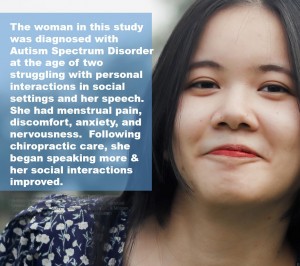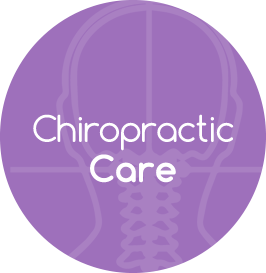Autism – FACTS 
Research is revealing that there is a relationship between abnormalities in the spine, the nervous system, and the brain
Basic science and clinical research shows that the proper development of the brain relies heavily on proper structure and movement of the spine from an early age.
Research has shown not only that the developing brain relies on normal structural integrity and joint movement, but that complex neurochemical communication and pathways involved in helping humans to “feel good” are tied into spinal biomechanics and their related neurological pathways.
Neurobehavioral disorders such as autism may be related to how the entire body communicates with the brain and the most critical area for this is the spine.
Some researchers believe that the increase in the diagnosis of such disorders as autism, ADHD, pervasive developmental disorder, Tourette’s Syndrome, obsessive compulsive disorder and other neurodevelopmental disorders, have their root in a “perfect storm” of abnormal spinal development.
People’s nervous systems need the constant stimulation of movement in order to develop and function properly. Abnormal position or movement of the spinal vertebra can develop and this can lead to nerve interference. It is this interference, called vertebral subluxations, that chiropractors correct.
Autism Spectrum Disorder (ASD) is described as a set of developmental disabilities that can lead to significant social, behavioral and communication restrictions.
There is an increase in incidence of autism all over the world, in all ages. Autism affects 1 in 45, roughly 2.21%, of adults in the United States and it affects 1 in 54, roughly 1.85 % of children in the United States.
At 18 months of age, autism can show the first concerns. Of those parents with children having ASD, studies have shown about one-third of them have noticed a problem occurring before the age of one year old. About 80% of the same parents involved in the study saw problems before 24 months. At this time, parents will notice a withdrawal or social disconnection.
The exact etiology remains unclear for ASD, however it is evident that there is pathology in the executive function of the cerebral cortices, which controls organization, time management and memory. According to researchers the nervous system controls and coordinates all functions of the body and structural shifts in the spine can occur that obstruct the nerves and interfere with brain function. It is this obstruction, called vertebral subluxations, that chiropractors correct. By removing the structural shifts, chiropractic improves nerve supply and brain function.
Adult Autism Improves Following Chiropractic Care
The 22-year-old female in this study had been diagnosed with Autism Spectrum Disorder which started after receiving a vaccine at the age of two. She was experiencing menstrual pain, discomfort, anxiety, and nervousness. She was limited in her daily activities like personal interactions and speech due to autism.
The chiropractor examined her and found postural abnormalities and structural shifts in her neck, mid back, and low back. Muscle imbalance, spasms, decreased range of motion, and additional testing confirmed these findings. These structural shifts can lead to obstruction of the nerves and it is this obstruction, called vertebral subluxations, that chiropractors correct.
Following chiropractic adjustments, her speech improved as she began talking more and her participation in daily personal interactions improved. There was an improvement of 41% in sociability and 24% improvement in health, physical symptoms and behavior according to measurements taken before and after care.
The study’s author called for additional research to investigate the clinical implications of chiropractic in this population.
Reference: Improved Behavioral Changes in an Adult with Autism Following Torque Release Technique for Correcting Vertebral Subluxation: A Case Study. Anthony Pellegrino, DC & Morgan Lightsey-Santos, DC. Annals of Vertebral Subluxation Research ˜ Volume, 2020.


